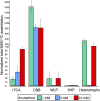Quantifying genome-specific carbon fixation in a 750-meter deep subsurface hydrothermal microbial community
- PMID: 38632042
- PMCID: PMC11075769
- DOI: 10.1093/femsec/fiae062
Quantifying genome-specific carbon fixation in a 750-meter deep subsurface hydrothermal microbial community
Abstract
Dissolved inorganic carbon has been hypothesized to stimulate microbial chemoautotrophic activity as a biological sink in the carbon cycle of deep subsurface environments. Here, we tested this hypothesis using quantitative DNA stable isotope probing of metagenome-assembled genomes (MAGs) at multiple 13C-labeled bicarbonate concentrations in hydrothermal fluids from a 750-m deep subsurface aquifer in the Biga Peninsula (Turkey). The diversity of microbial populations assimilating 13C-labeled bicarbonate was significantly different at higher bicarbonate concentrations, and could be linked to four separate carbon-fixation pathways encoded within 13C-labeled MAGs. Microbial populations encoding the Calvin-Benson-Bassham cycle had the highest contribution to carbon fixation across all bicarbonate concentrations tested, spanning 1-10 mM. However, out of all the active carbon-fixation pathways detected, MAGs affiliated with the phylum Aquificae encoding the reverse tricarboxylic acid (rTCA) pathway were the only microbial populations that exhibited an increased 13C-bicarbonate assimilation under increasing bicarbonate concentrations. Our study provides the first experimental data supporting predictions that increased bicarbonate concentrations may promote chemoautotrophy via the rTCA cycle and its biological sink for deep subsurface inorganic carbon.
Keywords: DNA stable isotope probing; deep biosphere; microbial carbon fixation; qSIP.
© The Author(s) 2024. Published by Oxford University Press on behalf of FEMS.
Conflict of interest statement
We declare no conflict of interest.
Figures




Similar articles
-
Linking Uncultivated Microbial Populations and Benthic Carbon Turnover by Using Quantitative Stable Isotope Probing.Appl Environ Microbiol. 2018 Aug 31;84(18):e01083-18. doi: 10.1128/AEM.01083-18. Print 2018 Sep 15. Appl Environ Microbiol. 2018. PMID: 29980553 Free PMC article.
-
Metagenomic Signatures of Microbial Communities in Deep-Sea Hydrothermal Sediments of Azores Vent Fields.Microb Ecol. 2018 Aug;76(2):387-403. doi: 10.1007/s00248-018-1144-x. Epub 2018 Jan 21. Microb Ecol. 2018. PMID: 29354879
-
Coupled RNA-SIP and metatranscriptomics of active chemolithoautotrophic communities at a deep-sea hydrothermal vent.ISME J. 2016 Aug;10(8):1925-38. doi: 10.1038/ismej.2015.258. Epub 2016 Feb 12. ISME J. 2016. PMID: 26872039 Free PMC article.
-
Metagenomic analysis of a high carbon dioxide subsurface microbial community populated by chemolithoautotrophs and bacteria and archaea from candidate phyla.Environ Microbiol. 2016 Jun;18(6):1686-703. doi: 10.1111/1462-2920.12817. Epub 2015 Apr 8. Environ Microbiol. 2016. PMID: 25727367
-
Microbial ecology of the deep terrestrial subsurface.ISME J. 2024 Jan 8;18(1):wrae091. doi: 10.1093/ismejo/wrae091. ISME J. 2024. PMID: 38780093 Free PMC article. Review.
Cited by
-
Metabolic diversity and adaptation of carbon-fixing microorganisms in extreme glacial cryoconite.ISME Commun. 2024 Mar 30;5(1):ycaf056. doi: 10.1093/ismeco/ycaf056. eCollection 2025 Jan. ISME Commun. 2024. PMID: 40259990 Free PMC article.
-
Editorial: celebrating the biogeosphere at the joint meeting of International Societies for Environmental Biogeochemistry and Subsurface Microbiology.FEMS Microbiol Ecol. 2025 Apr 14;101(5):fiaf049. doi: 10.1093/femsec/fiaf049. FEMS Microbiol Ecol. 2025. PMID: 40338622 Free PMC article.
-
Identifying the active microbes driving organosulfur cycling from taurine and methionine in marine sediment.ISME Commun. 2025 Feb 25;5(1):ycaf033. doi: 10.1093/ismeco/ycaf033. eCollection 2025 Jan. ISME Commun. 2025. PMID: 40083910 Free PMC article.
-
Principal role of fungi in soil carbon stabilization during early pedogenesis in the high Arctic.Proc Natl Acad Sci U S A. 2024 Jul 9;121(28):e2402689121. doi: 10.1073/pnas.2402689121. Epub 2024 Jul 2. Proc Natl Acad Sci U S A. 2024. PMID: 38954550 Free PMC article.
-
Hydrogen-dependent dissimilatory nitrate reduction to ammonium enables growth of Campylobacterota isolates.ISME J. 2025 Jan 2;19(1):wraf092. doi: 10.1093/ismejo/wraf092. ISME J. 2025. PMID: 40367351 Free PMC article.
References
-
- Akkuş İ, Akıllı H, Ceyhan S et al. Türkiye jeotermal kaynakları envanteri (Geothermal resources inventory of Turkey). In: Akkuş İ, Akıllı H, Ceyhan S, et al. (eds.), Maden Tetkik ve Arama Genel Müdürlüğü. Çukurambar: General Directorate of Mineral Research and Exploration, 2005.
-
- Ali M, Jha NK, Pal N et al. Recent advances in carbon dioxide geological storage, experimental procedures, influencing parameters, and future outlook. Earth Sci Rev. 2022;225:103895.
-
- Alneberg J, Bjarnason BS, de Bruijn I et al. Binning metagenomic contigs by coverage and composition. Nat Methods. 2014;11:1144–6. - PubMed
-
- Amend JP, Shock EL. Energetics of overall metabolic reactions of thermophilic and hyperthermophilic archaea and bacteria. FEMS Microbiol Rev. 2001;25:175–243. - PubMed
-
- Barry PH, de Moor JM, Giovannelli D et al. Forearc carbon sink reduces long-term volatile recycling into the mantle. Nature. 2019;568:487–92. - PubMed

